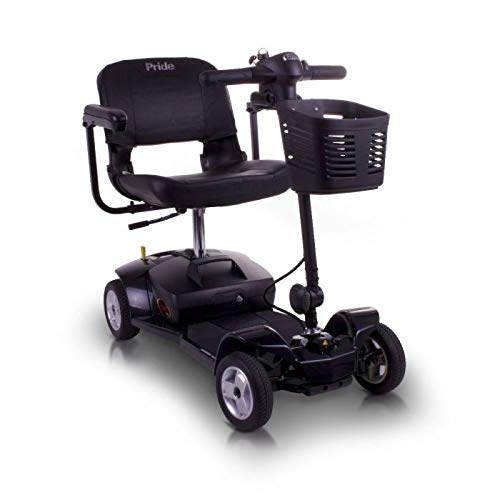A medical mobility scooter can be an ideal way for wheelchair users get around. It comes with a wide foot deck, and its wheels have a tighter turn radius than electric wheelchairs.
It also has ample storage space. Additionally, some portable models can break down into smaller pieces and fit in a car trunk.
Obtaining a Medical Scooter Through Medicare
You may be eligible to Medicare to pay for the cost of a mobility scooter if you have difficulty moving around without a wheelchair or walker. Medicare Part B will cover up to 80% of cost of medical mobility scooters if you meet certain criteria. To find out if you're eligible for coverage, talk to your doctor and then find an approved Medicare provider that accepts assignment.
A medical scooter is a durable medical device (DME) as defined by Medicare Part B. This means that you have to attend a meeting with your doctor before Medicare will cover it. A doctor will review your situation and determine if you're in need of a scooter to move around your home. If they do they'll write prescriptions that allow Medicare to pay for the cost of the device.
Once you have an approved prescription, you can begin shopping for the perfect scooter. When choosing a scooter, there are numerous factors to consider. This includes the weight capacity and turning radius. It is also important to make sure the scooter is suitable for use outside of your home and can handle various terrains.
You'll need to check your plan's coverage prior to purchasing a scooter. Some plans have a deductible so it's crucial to study them prior to making a decision. It is also important to look at the benefits of different models and brands. Some are more affordable and you should think about the features you require.
The Medicare scooter coverage amounts differ from plan to plan, but they all meet the same basic requirements. You must be registered in Medicare Part B to receive the benefits, and also a doctor to prescribe it to you. The doctor must also ensure that you're not able to get around your home without it. In the majority of cases, scooters are only covered when they are used indoors.
A Medicare-approved DME provider will assist you to select the right scooter suitable for you. They'll visit your home and examine the space to determine whether your scooter can maneuver through the furniture, hallways, and doors. They'll also test the motor to make sure it is able to handle your weight and range of terrains.
Scooters that are Medicare-approved come in a variety of sizes and designs. Some are designed as a fashion statement, while others are designed with performance that is superior in the mind. The Maxima medical scooter is a great example of a stylish mobility scooter that provides outstanding mobility scooter near me for sale (please click the up coming article) and performance. It can support up 500 pounds and has a top-speed of 5.3 miles per hours. It is available in two colors: Candy Apple Red and Viper Blue.
 Medicaid and Medical Scooters
Medicaid and Medical ScootersThere are numerous funding options for those with limited mobility due to a medical condition. These include Medicare and Medicaid that provide aid to those who meet eligibility requirements. Consult a healthcare professional before selecting the kind of medical scooter right for you.
Generally speaking, Medicare Part B pays for durable medical equipment (DME) like mobility scooters based on the prescription of a doctor and a demonstration of a need for the device. To obtain coverage, you should start by calling your local Medicaid office to determine whether you're eligible. If you're eligible, choose the DME provider that accepts Medicaid. They should also be able to work with you and your physician to collect all necessary documents.
Choose the model that is most suitable for your medical needs after you've found an DME provider that accepts Medicaid. Consider factors such as turning radius, weight of the assemble, and ground clearance. A three-wheeled scooter can be more easily maneuvered around tight spaces and corners than those with four wheels. Weight of the assemble is also important to be aware of because lighter scooters are easier to transport and assemble.
Some states offer additional programs to help with the purchase or rental medical scooters. To learn more about these programs, contact your local Department of Health and Department of Aging. Veterans Affairs also provides various mobility aids to disabled veterans who qualify.
The process of obtaining a medical scooter through Medicaid can be long, but it is important to be patient. By working closely with your healthcare provider, analyzing details about coverage, and staying in constant communication with your DME supplier to ensure that the process of acquiring a medical scooter through Medicaid is as easy as you can.
You might also be able to purchase a scooter from your insurance company or other funding sources like grants and community groups. However, the exact process will vary by state and entity. You can check with local disability groups or independent living centres to determine the options available in your local area. These organizations might be able to suggest local companies that provide Medicaid-approved scooters. They might also be able assist you apply for.
Insuring a medical scooter with private insurance
In addition to Medicare, private health coverage may also cover mobility scooters. In this case the insurance company will evaluate medical necessity and other requirements. This could include a face to face examination and a prescription from a certified healthcare professional. The scooter should also be considered necessary for daily activities, and it must meet certain weight capacities and other requirements. Certain insurance plans for private customers will cover the accessories.
Typically, medical scooters are covered by Medicare Part B if they're considered durable medical equipment (DME). The device will be covered up to 80% after the deductible is satisfied. However, the user is responsible for the remaining 20 percent. This rule applies to all types of scooters, including four-wheel and three-wheel models. There are exceptions to the rule. For instance, certain models are too big to be considered mobile and require towing behind a vehicle.
To purchase a medical scooter under private insurance the first step is to get the prescription of a physician. Then, the patient must find a DME company that will accept insurance. The DME company will then send the medical documents and order forms to the insurance for approval. Once the insurance has approved your order, you will receive the medical scooter.
One important thing to remember about purchasing a medical scooter through private insurance is that the device must be used for everyday activities. It must be able to help the user move around and perform routine tasks such as bathing, dressing and eating. The scooter can also be used to travel between and within the home. In some instances, medical scooters can be used for shopping.
In some states, Medicaid may also cover the cost of a medical scooter. However, different rules apply in each state. In certain states, Medicaid only covers scooters that are rented from a Medicare-contracted provider. This is known as the Competitive Bidding Program. In other situations the Medicaid program might only provide a medical scooter when it's an existing model that's accessible at a reasonable cost.
A medical mobility scooter is an ideal tool to aid those who have limited mobility. Scooters can help people regain their independence after an accident or illness. In many instances medical scooters are a better alternative to wheelchairs. It offers more stability and comfort which makes it the ideal option for those who wish to remain mobile. A medical scooter is a great option for those who have difficulty standing or walking for prolonged durations of time.




